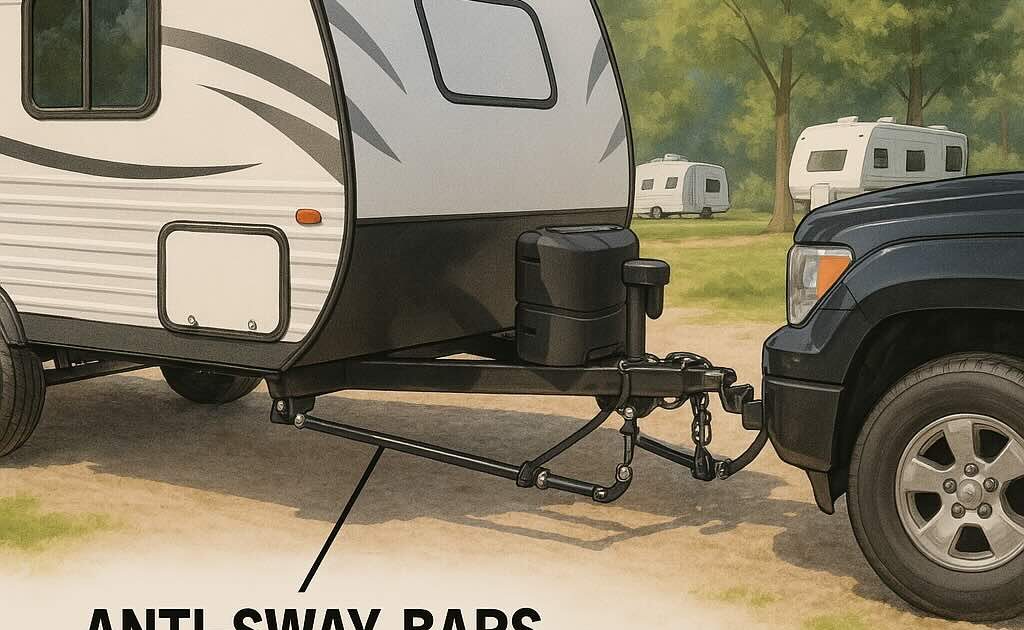If your travel trailer feels unstable while towing—especially when passing big trucks or driving in wind—anti-sway bars might be the upgrade you need. These devices help keep your trailer steady, reduce fishtailing, and make your towing experience safer and more comfortable.
At Custom-way, we install and service anti-sway and weight distribution systems for RV owners across California. In this guide, you’ll learn what sway bars do, how to use them properly, and why they’re essential for anyone towing a trailer.
What Are Anti-Sway Bars?
Anti-sway bars (also known as sway control bars) are towing accessories that reduce the side-to-side motion of a trailer, known as trailer sway or “fishtailing.”
They work by creating resistance to lateral movement between your tow vehicle and the trailer, helping to keep everything straight—especially during:
-
Crosswinds
-
Highway lane changes
-
Sudden braking or acceleration
-
Uneven road surfaces
Custom-way Tip: Anti-sway bars are often used with weight distribution hitches, but they can also be installed as standalone systems.
Types of Anti-Sway Bars
There are two main types:
1. Friction Sway Control Bars
-
Use adjustable friction to resist trailer movement
-
Simple to install and budget-friendly
-
Work best on smaller or mid-size trailers
2. Integrated Sway Control with Weight Distribution Hitch
-
Combines sway control with weight distribution
-
Offers better performance for heavier trailers
-
Ideal for full-time RVers and long-distance towing
How to Use Anti-Sway Bars: Step-by-Step
1. Hook Up the Trailer as Usual
Start by connecting your trailer to your tow vehicle using your regular hitch and coupler.
2. Mount the Sway Bar to the Hitch
Your sway control bar attaches to a ball mount or bracket on the hitch side. Secure it with the included bolts or locking pins.
3. Attach the Bar to the Trailer Frame
The other end of the sway bar mounts to a bracket installed on the trailer’s A-frame. This setup allows the bar to create friction between the trailer and tow vehicle.
📌 Most kits come with detailed instructions, but you can also have this installed professionally to ensure correct placement and angle.
4. Adjust the Tension
Use the built-in handle or tightening knob to set the friction level. You want enough resistance to reduce sway—but not so much that turning becomes difficult.
5. Drive, Then Fine-Tune
Test your setup by driving slowly and making a few wide turns. Adjust tension as needed.
Important Safety Tips
-
Turn off sway control in slippery conditions (rain, ice, gravel roads), as friction can affect trailer tracking.
-
Remove sway bars before backing up, unless your model allows backing with them connected.
-
Check bolts and brackets before each trip to ensure everything is tight and secure.
💡 At Custom-way, we offer installation and adjustment services to help you get the perfect setup for your trailer size and towing vehicle.
Do You Need Sway Control?
You might benefit from sway bars if:
-
Your trailer is over 20 ft long
-
You tow in windy or hilly areas
-
Your trailer sways when passed by trucks
-
You feel steering corrections while towing
-
You tow at highway speeds regularly
We Install Anti-Sway Bars in California
Custom-way offers:
-
Anti-sway bar installation
-
Weight distribution hitch setups
-
Inspection and adjustment services
-
Mobile towing equipment upgrades
Whether you’re a weekend camper or a full-time traveler, our expert team will help you tow with confidence.
📍 Serving Southern California with mobile RV service at your home, storage yard, or campground.
Safer Towing Starts with Custom-way
Don’t let trailer sway ruin your trip—or risk a dangerous situation on the road. Contact Custom-way for professional anti-sway bar installation and towing system upgrades.

